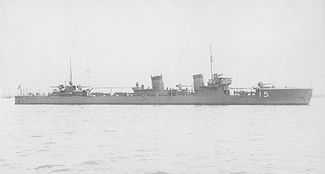Japanese destroyer Asanagi
 Asanagi on December 29, 1924 | |
| Career | |
|---|---|
| Name: | Asanagi |
| Owner: | Empire of Japan |
| Operator: | Imperial Japanese Navy |
| Builder: | Fujinagata Shipyards, Japan |
| Yard number: | Destroyer No. 15 |
| Laid down: | March 5, 1923 |
| Launched: | April 21, 1924 |
| Commissioned: | December 29, 1925 |
| Renamed: | Asanagi August 1, 1928 |
| Struck: | July 10, 1944 |
| Fate: | Sunk in combat, May 22, 1944 |
| General characteristics | |
| Class and type: | Kamikaze-class destroyer |
| Displacement: | 1,400 long tons (1,400 t) normal, 1,720 long tons (1,750 t) full load |
| Length: | 97.5 m (320 ft) pp, 102.6 m (337 ft) overall |
| Beam: | 9.1 m (30 ft) |
| Draught: | 2.9 m (9.5 ft) |
| Propulsion: | 2 shafts 4 x Ro-Gō Kampon water-tube boilers 2 x Kampon geared turbines 38,500 ihp (28,700 kW) 2 shafts |
| Speed: | 36.88 knots (68.30 km/h) |
| Range: | 3600 nm @ 14 knots (6,700 km at 26 km/h) |
| Complement: | 168 |
| Armament: | 3 ×Type 3 120 mm 45 caliber naval gun 10 × Type 96 25 mm AT/AA Guns 4 × 21 inch torpedo tubes 16 × naval mines |
| Service record | |
|---|---|
| Operations: |
Battle of Wake Island New Guinea Campaign Solomon Islands Campaign |
Asanagi (朝凪 ”Morning Calm”)[1] was the eighth vessel of the Kamikaze-class destroyers built for the Imperial Japanese Navy following World War I. Advanced for their time, these ships served as first-line destroyers through the 1930s, but were considered obsolescent by the start of the Pacific War.
History
Construction of the large-sized Kamikaze-class destroyers was authorized as part of the Imperial Japanese Navy's 8-4 Fleet Program from fiscal 1921–1923, as a follow on to the Minekaze class, with which they shared many common design characteristics.[2]Asanagi, built at the Fujinagata Shipyards, in Osaka was laid down on March 5, 1923, launched on April 21, 1924 and commissioned on December 29, 1925. [3] Originally commissioned simply as "Destroyer No. 15", it was assigned the name Asanagi on August 1, 1928.
World War II history
At the time of the attack on Pearl Harbor, Asanagi was assigned to Destroyer Division 29 of Desron 6 in the IJN 4th Fleet, based at Truk. It provided cover for the Gilbert Island invasion force from December 8–10, 1941, and subsequently was assigned to the second Wake Island invasion force from December 23.
From January through March 1942, Asanagi provided cover for landings of Japanese forces during "Operation R" (the invasion of Rabaul, New Britain) and "Operation SR", (the invasion of Lae and Salamaua. While patrolling out of Lae on March 10, she suffered medium damage from strafing attacks, forcing a return to Sasebo for repairs by April. Once repairs were completed in June, Asanagi escorted convoys from Sasebo back to Truk. During the Battle of the Coral Sea from May 7–8, 1942, Asanagi was assigned to the "Operation Mo" invasion force for Port Moresby on New Guinea. When that operation was cancelled, she returned to Sasebo for further repairs.[4]
Asanagi returned to Rabaul in mid-July and was assigned to cover Japanese landings on Buna. While making troop landings at Buna, Asanagi suffered damage by grounding on a coral reef while maneuvering to escape an air raid, and was forced to return to Yokosuka for repairs. She spent the remainder of September through November 1943 on patrols and escort duty in the central Pacific, and between Truk, Rabaul and the Japanese home islands.
In 1944, Asanagi escorted numerous convoys between Yokosuka, Truk, the Ogasawara Islands and the Mariana Islands. On her return from Saipan to Japan on May 20, 1944, she was torpedoed and sunk 200 miles (320 km) west-northwest of Chichijima in the Ogasawara islands 28°20′N 138°57′E / 28.333°N 138.950°ECoordinates: 28°20′N 138°57′E / 28.333°N 138.950°E by the United States Navy submarine USS Pollack (SS-180).[5]
Asanagi was struck from the navy list on July 10, 1944.[6]
References
- Brown, David (1990). Warship Losses of World War Two. Naval Institute Press. ISBN 1-55750-914-X.
- Dull, Paul S. (1978). A Battle History of the Imperial Japanese Navy, 1941-1945. Naval Institute Press. ISBN 0-87021-097-1.
- Howarth, Stephen (1983). The Fighting Ships of the Rising Sun: The Drama of the Imperial Japanese Navy, 1895–1945. Atheneum. ISBN 0-689-11402-8.
- Jentsura, Hansgeorg (1976). Warships of the Imperial Japanese Navy, 1869–1945. US Naval Institute Press. ISBN 0-87021-893-X.
- Nelson, Andrew N. (1967). Japanese–English Character Dictionary. Tuttle. ISBN 0-8048-0408-7.
- Watts, Anthony J (1967). Japanese Warships of World War II. Doubleday. ASIN B000KEV3J8.
- Whitley, M J (2000). Destroyers of World War Two: An International Encyclopedia. London: Arms and Armour Press. ISBN 1-85409-521-8.
External links
- Nevitt, Allyn D. (1997). "IJN Asanagi: Tabular Record of Movement". Long Lancers. Combinedfleet.com.
- Nishidah, Hiroshi (2002). "Kamikaze class 1st class destroyers". Materials of the Imperial Japanese Navy.
- Jones, Daniel H. (2003). "IJN Minekaze, Kamikaze and Mutsuki class Destroyers". Ship Modeler's Mailing List (SMML).
Notes
- ↑ Nelson. Japanese-English Character Dictionary. Pages 749, 480
- ↑ Howarth, The Fighting Ships of the Rising Sun.
- ↑ Nishidah, Hiroshi (2002). "Kamikaze class 1st class destroyers". Materials of the Imperial Japanese Navy.
- ↑ Nevitt, Allyn D. (1997). "IJN Asanagi: Tabular Record of Movement". Long Lancers. Combinedfleet.com.
- ↑ Brown. Warship Losses of World War Two
- ↑ Nishidah, Hiroshi (2002). "Kamikaze class 1st class destroyers". Materials of the Imperial Japanese Navy.
| ||||||||||||||